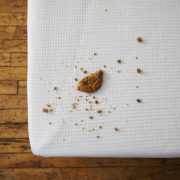There’s no one-size-fits-all mattress thickness. The thickness and density of your mattress should be determined by your body weight, preferred sleeping position, and your unique preferences. It is also worth considering the aesthetic of your bedroom. If you’re shopping for a new mattress, you should select a thickness that suits your individual needs. In this article, we’ll show you how.
What Determines Mattress Thickness?
Mattresses are complex structures that have many internal components and layers. Each layer of the mattress provides a specific function to aid the user’s sleep quality, such as temperature control or pressure point relief. The various layers included in a mattress, which we’ve listed below, are what determine the thickness of a mattress.
Comfort Layer
The comfort layer sits at the top of the mattress underneath the quilted surface. This layer is composed of a plush layer of memory foam or gel infused high density foam, which provides pressure point relief. The thickness of the comfort layer is between 1-2 inches according to one’s desired comfort level. It is possible to have multiple comfort layers.
Support Layer
The support layer lies directly underneath the comfort layer and consists of a stable and thick foundation built with wrapped coils that absorb the sleeper’s body weight. The support layer is usually 3-5 inches in thickness depending on the mattress height and the type of mattress (i.e., innerspring, hybrid, or memory foam). It is typical to have multiple support layers.
Other Layers
The base layer is at the bottom of the mattress and it provides core stability for the wrapped coils and springs to sit on. The base layer rubs against the bottom mattress cover and adds stability to the mattress. This layer is usually no more than one inch in thickness.
Mattress Toppers and Pillow Tops
Mattress toppers and pillow tops sometimes sit on top of the mattress’s comfort layer to provide additional softness and breathability. These layers typically range between 1-3 inches in thickness.
Mattress Thickness Guide
Low Profile Mattresses
Low profile mattresses are thin mattresses that typically measure 3 or 4 inches thick. Usually, low profile mattresses are made purely of gel-infused foam and plush memory foam and are suitable for side sleepers who like a softer sleeping surface. These are generally much cheaper and not great long term solutions.
Slim Mattresses
A slim mattress is usually 5 to 7 inches thick. Slim mattresses are usually not thick enough to accommodate springs or coils, so these mattresses are often made of latex, cotton, wool, and various foam mattress materials. A 7-inch mattress is adequate for a light side sleeper with mild back pain who wants a medium-soft bed. Again, these beds tend to be cheaper quality.
Standard Mattresses
Standard mattresses are between 8 and 10 inches in thickness. These are often memory foam mattress types that sometimes feature innerspring coils (i.e., hybrid mattresses) to help provide pressure relief for sore sleepers.
Medium-Thick Mattresses
Medium-thick mattresses are bulky mattresses that are 11 or 12 inches in thickness. A 10-inch mattress or 12-inch mattress almost always include innerspring coils as well as several layers of foam and natural materials to support the sleeper’s body weight and provide structural support for those with back pain or joint soreness.
Thick Mattresses
A thick mattress is one that measures more than 12 inches in thickness. These mattresses have several layers, including a prominent wrapped coil midsection for extra support for sleeper’s pressure points while also providing a soft top layer and stable foundation.
Benefits of A Thicker Mattress
There are many reasons why you should consider investing in a thicker mattress (i.e., 10 inches or thicker). We’ve listed some of the top reasons below:
- Side sleepers have additional material to cushion their hips and shoulders
- Prevent rolling over and tossing and turning during one’s sleep
- Can absorb the weight of heavier individuals
- Tend to be made of high-quality innerspring coils
- Can support the bodyweight of two people sharing the bed
What About A Thin Mattress?
Thin mattresses are also beneficial for many sleepers. If you prefer the thickness of your mattress to be a bit thin, here are some of the benefits you might realize:
- Much less expensive
- Promote better airflow by not having the sleeper’s body sink into the mattress
- Are easier to flip over and clean mattress regularly
- Allow for better spinal support for stomach sleepers
What Mattress Thickness Should You Choose?
Neither a thick or thin mattress is better than any other. Rather, the thickness of your mattress should be determined by your body’s unique needs and your sleeping style. If you’re looking for a new bed with the right thickness, take the Helix Sleep Quiz and find a personalized match for your body and sleep position.

















